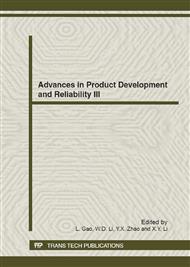[1]
Rosenthal D. Theory of moving source of heat and its application to metal treatments [J]. Transactions of American Society of Mechanical Engineers, 68: 849-866, (1996).
Google Scholar
[2]
Yu G, Anderson R J, Maekawa T. Efficient simulation of shell forming by line heating [J]. International Journal of Mechanical Science, 43: 2349-2370, (2001).
DOI: 10.1016/s0020-7403(01)00037-6
Google Scholar
[3]
Kyrsanidi A K, Kermanidis T B, Pantelakis S G. Numerical and experimental investigate ion of the laser forming process [J]. Journal of Materials Processing Technology 1999, 87: 281-290.
DOI: 10.1016/s0924-0136(98)00367-7
Google Scholar
[4]
Yu G, Masubuchi K, Maekawa T, Patrikalakis NM. A finite element model for metal forming by laser line heating [A]. Proceedings of the 10th International Conference on Computer Applications in Shipbuilding, ICCAS'99, vol. 2: 409-418, (1999).
Google Scholar
[5]
Liu Yujun, Ji Zhuoshang, Dai Yinsheng. Regression analysis of parameters in line heat forming for steel plate [J]. Shipbuilding of China, 1: 65-72, 1994 (In Chinese).
Google Scholar
[6]
Truong Thinh Nguyen1, Young-Soo Yang, Kang-Yul Bae and Sung-Nam Choi. Prediction of Deformations of Steel Plate by Artificial Neural Network in Forming Process with Induction Heating. Journal of Mechanical Science and Technology, 23, 1211-1221, (2009).
DOI: 10.1007/s12206-009-0101-5
Google Scholar
[7]
Liu Bin, Jiang Zuhua, Yu Chengquan and Jiang Zhibin. The Line-heating Deformation Prediction Method Based on FEA and ANN [J]. Shipbuilding of China, 47 (2): 120-124, 2007 (In Chinese).
Google Scholar
[8]
Yao ZH. Study on Several Critical Techniques of Steel Plate Forming by Line Heating [M]. Huazhong University of Science and Technology, 2012 (In Chinese).
Google Scholar
[9]
Xiebiao Zhao. Research on Ship-hull Curved Plate Forming by Pure Line Heating [D]. Dalian University of Technology, 2005 (In Chinese).
Google Scholar
[10]
Cândida Ferreira. Gene Expression Programming: a New Adaptive Algorithm for Solving Problems. Arxiv preprint cs/0102027, (2001).
Google Scholar
[11]
Dashuan Dong. Forming Mechanism of Line Heating and Technical Parameters Determination [D]. Shanghai Jiao tong University, 2002 (In Chinese).
Google Scholar
[12]
Yao ZH, Gao L, Xiao M and Yang L. DOE-Based Numerical Investigation on Factors Affecting Temperature Field during Line Heating. Proceedings of International Conference on Advanced Design and Manufacturing Engineering (ADME 2011), 2011, Guangzhou, China. Advanced Materials Research, Vol. 314-316, 620-625, (2011).
DOI: 10.4028/www.scientific.net/amr.314-316.620
Google Scholar


